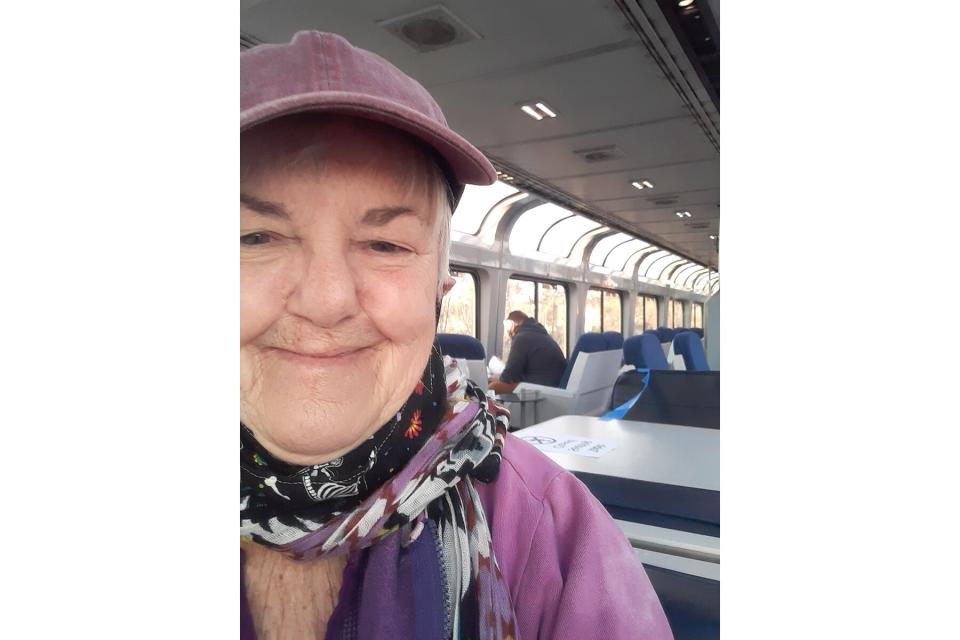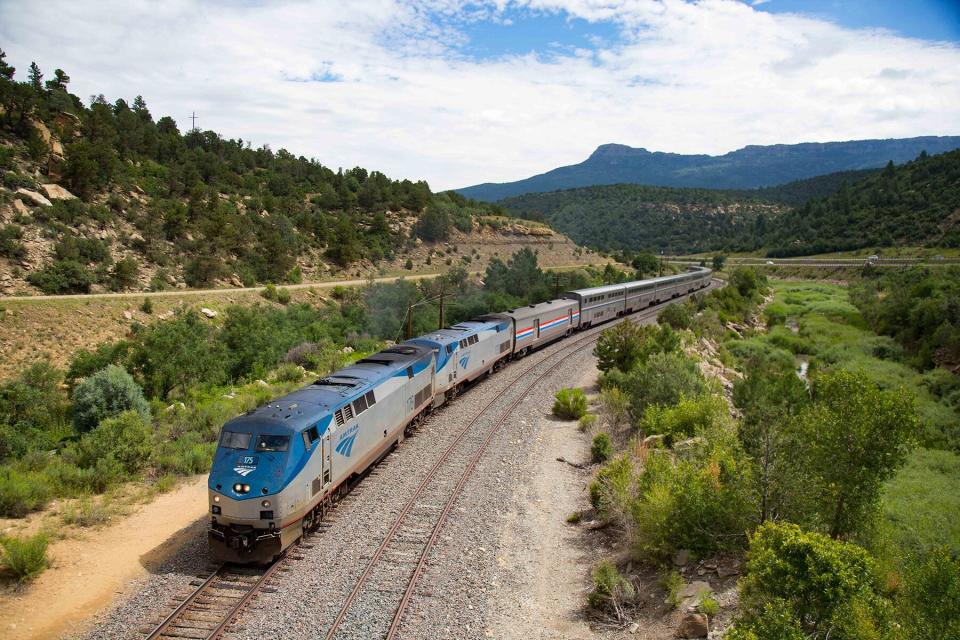How Amtrak Trains Became One Retired Traveler's Sanctuary During the Pandemic
In the early hours of a cool morning in October 2020, the Cardinal traced a creek through the outskirts of Cincinnati and lumbered into Union Terminal. The enormous and echoing train station was nearly deserted.
For months, as death spread and the world watched desperately from homes, afraid to go outside and afraid to breathe, the Cardinal left Union Terminal at 1:41 a.m. as it always has.

Courtesy of Rita Brooks
On this particular night, a small woman with short, sawtoothed white hair walked onto the platform. She carried with her two heavy bags, more than she needed. She spoke quietly to an attendant, exchanging a few words before boarding the half-empty train. It was late, but she gazed out the windows as the Cardinal pulled slowly past boxcars and rails, gaining speed and spilling out into the world, pounding across the earth toward Chicago, Denver, and California.
Related: More train trip ideas
Taking a Risk
When the pandemic hit Covington, Kentucky, Rita Carol Brooks believed she was going to die. She was 74 years old. She had already struggled with her health over the years. And she was losing her will to live.

Courtesy of Rita Brooks
Brooks, who used to work with children with disabilities, had been living in near total isolation for almost eight months when she made the decision to leave town. It seemed the only way to survive.
"I knew I was taking a risk, but at that point, it didn't matter," Brooks said. "I didn't want to be the person I was becoming."
Even before the pandemic, she could feel that she was slipping deeper into herself. She had recently lost all her teeth, and her high school anxieties about her cleft palate were returning. She didn't want to be seen in public, didn't want to eat around others, didn't want to talk to others. Her family had all passed away. She was becoming a recluse.
On the verge of touching a darkness she hoped she would never reach, Brooks bought an eight-day train ticket across the country. Years before, just after graduating college, she had taken a train to see the Grand Canyon. That memory felt like a lifeline — a feeling of possibility she wanted to claw back.
She wasn't the only one who used the rails as a safety net. Other older adults who struggled with isolation and loneliness during the pandemic have turned to long distance rail travel as a way to reconnect with the world. Whereas planes and airports might seem to still present a risk of COVID-19 transmission, trains feel like a viable alternative.

Marc Glucksman/Courtesy of Amtrak
According to Amtrak data, seniors are major stakeholders in the long-distance rail network — they make up 24% of all people riding Amtrak's long-distance routes. In some corridors, such as Virginia to Florida, they make up more than 60%.
Matthew Phillips, AARP's director of travel, said long-distance bookings with the organization's rail travel partners had already begun to rebound to pre-pandemic levels by summer 2021. For people who cannot drive or have difficulty navigating roads and airports, trains offer another option. Plus, with fewer European travel opportunities, older Americans are looking for domestic travel that offers shared experiences and a way to meet people.
"For those looking for that romanticized ideal of a train journey, they do exist," Phillips said.
Beyond that, among older Americans, the pandemic seemed to accentuate a distinct feeling that time was running out. For people like Brooks, riding the rails was a way to age with forward momentum. And it coincides with travel being one of the top ways people say they want to spend time when they retire, according Phillips. Actually achieving that goal is much harder — especially now. Gauging the health risks of COVID-19 exposure can be difficult. Navigating the physical infrastructure associated with traveling isn't easy, and medical conditions can make the experience even more fraught.
During a traumatizing year in which older adults were especially at risk of a severe coronavirus infection and made up the overwhelming majority of those who died, travel was tantamount to laying your life on the line.
Related: The Best Train Trips to Take Across America
Watching the Country Wake Up

Marc Glucksman/Courtesy of Amtrak
After a quick transfer in Chicago, Brooks found herself sitting alone in the observation car of the California Zephyr with a gin and tonic in hand. The plains unfolded before her. When night came, she returned to her coach seat, a book in hand, and then slept sitting upright until the sun rose again.
In Denver, she saw heavy snow for the first time in years.
In San Francisco, she watched the sun set over the Pacific.
In Portland, she saw the train wind through the deep green of the Willamette Valley.
As the days went on, Brooks found herself talking to people more. Every morning she would return to the observation car to watch the sun rise, making conversation with the folks who would walk up to watch the country wake up. She found herself smiling again. When she first saw the Rocky Mountains lifting out of a thin layer of mist, she cried. It was the most beautiful thing she had ever seen.
"It saved my life," Brooks said.
"Trains are actually the ideal kind of compromise," said Dr. Dilip Jeste, the senior associate dean for Healthy Aging and Senior Care at the University of California San Diego. "You get to know people, but you can avoid people you don't like. There are breaks you can take at every station, and if you make friends, you can play cards. In a plane, you're only talking to the person you sit next to."
There's an element of eternal youth in the way we view trains and cross-country travel. It's as if when we see trains barreling across the landscape, we can almost imagine a time when America was young again, when all that was left to do was watch it grow into a place we all wanted it to become. That romanticism is evident in the names of the trains themselves — the Texas Eagle, the Heartland Flyer, the Empire Builder. That feeling of nostalgia and connectedness is valuable to everyone. But in the pandemic and post-pandemic world, it might be older Americans who need it the most.
Still, traveling long distances on a train as an older person poses challenges. It's expensive — a round trip on the Southwest Chief from Chicago to Los Angeles could cost about $350. Sleeper rooms usually cost over $1,000. Amtrak offers only a 10% discount for people over the age of 65 and doesn't allow the discount to be used for sleeping accommodations or in the popular Virginia-to-Florida corridor. Brooks is just getting by, and she openly acknowledges she has spent far more of her savings than she should have on her two cross-country trips since last October. Trains are slow, sometimes with long delays. For people with medical conditions, remaining stuck in place for days at a time is a nonstarter.

Marc Glucksman/Courtesy of Amtrak
However older people can achieve it, some medical professionals, such as Dr. Leah Witt, geriatrician and pulmonologist at UCSF Health, are increasingly recommending their patients return to travel and visit family and friends. Their health might depend on it. Loneliness has been shown to increase the risk of diabetes, heart disease, depression, dementia, substance abuse, obesity, and suicide. And research shows that cognitive decline comes faster for people who are sedentary.
The key is momentum. For Brooks, the train provided that.
When Brooks returned to Cincinnati after last October's trip, she almost immediately booked her next train excursion. But that didn't feel like enough. She knew there must be other people out there who felt as isolated as she had.
"I always thought if I didn't have this cleft palate, if I was pretty, then I would be happy," Brooks said. "That's not how it works. And it takes you a whole damn lifetime to figure it out."
Brooks shares her experience wherever she can. She keeps in touch with other people she met on the train and started a social media group to inspire other older adults to try the rails. In July, one of the women she met online, Danielle Withrow, came to visit her in Kentucky. They met for dinner, talked about trains, their travels, and Union Terminal. Through that alone, they've forged a friendship.
"She does a real service to help older Americans think, 'Yeah, I could get on a train,'' Withrow said. "And when you look out the window of a train, you see America."
On October 7, 2021, Brooks boarded the Cardinal at 1:41 a.m. again. She walked through the silent terminal and found her coach seat. She drifted off to sleep to the rhythm of the tracks, headed somewhere new again.
"It's up to you to find out what flips your switch, what makes you happy," Brooks said. "I plan to keep moving until there's a good reason not to."
Will McCarthy is a writer with the Investigative Reporting Program at the University of California, Berkeley, Graduate School of Journalism. The IRP reported on this story through a grant from The SCAN Foundation.


